Following is from the PTI report on this.
The government today approved an area of 935 acres near Jatni in Khurda district of Orissa as the site for the proposed IIT in the state.
"There were four possible sites for the top institute. But the government approved the location near Jatni as it has vast land area and is near to airport. The rail and road connectivity is very good to this place," a top HRD Ministry official told PTI here.
HRD Minister Arjun Singh will visit the state soon to lay the foundation stone for the elite technical institute, the official said.
He said the ministry had sent its site identification committee to the state on December 24 and 25 last year. The committee visited the sites near Jatni, Banki, Ramdaspur and Gayabandha.
"Among all the places, the committee found location near Jatni was the best from the point of view of future and growth prospects of the institute," he said.
… "The Centre also asked the state government to transfer the land to the IIT Society of IIT Bhubaneswar immediately so that the construction of the building and other facilities can be started," he said.
January 13th, 2009
He was previously at the MHRD. See here.
Bata Kishore Ray/
(Asst Financial Adviser) |
234-C Shastri BhavanDr. Rajendra Prasad RoadDelhi
Pin: – 110001
Tel: – 23388608Fax: – 23388608
Category – Central Secretariat Services
Organisation – Ministry of Human Resource Development
Email – bkray@nic.in |
January 1st, 2009
Update: Excerpts from a report in Kalinga Times.
Aragul near Jatni has been finally chosen as the place for setting up of the Indian Institute of Technology, Bhubaneswar.
A four-member Central team sent by the Union Ministry of Human Resource Development selected Aragul after visiting four different places.
The team comprised Ashok Thakur, Additional Secretary in the Union Ministry of Human Resource Development; Damodar Acharya, Director of IIT Kharagpur; A.K. Dey, former Director of IIT Mumbai; and K. Narayan Rao, Secretary of All-India Council for Technical Education (AICTE).
The place selected is 12 km from Bhubaneswar airport by road and four km away from Jatni railway junction.
Following are excerpts from a report in tathya.in.
Ashok Thakur is impressed with Argul.
The Chairman of the Site Selection Committee for the IIT-Bhubaneswar found the site near Jatni a ‘nice’ one.
… The State Government has identified Argul near Jatni and Malipada near Khurda.
Both are in Khurda district.
Secondly Ramdaspur near Naraj and Dampada near Banki in Cuttack district were also identified for the purpose.
Mr.Thakur himself visited Argul on 25 December and expressed satisfaction over the place, said sources.
It is 891 acre of land out of which 500 acres are readily available.
Very near to the Capital city and well connected with rail and road.
Institutions like NISER, various engineering colleges and other institutions are coming up in the near by area.
This place was favored by the State Government for the IIT-Bh as the most suitable one.
It looks very likely that Argul will be chosen for the IIT site. But the others sites would soon come into play; especially for the world class central university (national university).
December 25th, 2008
(This is inspired by the post http://iitbbs.blogspot.com/2008/12/latest-news.html.)
The IIT Bhubaneswar will be temporarily located in the IIT Kharagpur Extension Center. It is located 1km from the NH-5 Jaydev Vihar exit towards Nandan Kanan. It is behind Ginger hotel and Swosti Plaza hotel. Across these two hotels is the Trident Oberoi and about 300 mts away is the Mayfair lagoon Hotel. Each of these hotels have many nice restaurants. About 700 mts from IIT location is the Pal Heights shopping complex that has a very good restaurant as well as an Oxford book store. About 500 mts the other direction is the Sandy’s Square which has a Smoking Joes Pizza.
Next to the IIT location is the Shyamasam Dham, one of the Main Ashrams of Jagadguru Kripalu Parishat.
About 150-200 mts to the IIT location is Gandhi Park and Janata Maidan. The later can be a ground to play outdoor games such as Cricket, Football and Hockey.
The IIT location is in the North east corner of the large Institute of Mineral and Materials Technology (formerly RRL) campus. It is expected that the IIT students will have access to this campus and some of its amenities including its outdoor playing areas. The Kalinga Stadium and its swimming pool is about 1.5 kms from the IIT location.
The Maharaja theater is 2 kms away. XIMB (Basketball, Tennis courts, Football ground, auditorium) is 600 mts away. Institute of Physics is 700 mts away. Utkal University is 1 km away.
The ESI Hospital is about 250 mts from the IIT location and Kalinga Hospital is about 1 kms away. (Next to Kalinga Hospital is the Institute of Life Sciences and Regional Medical research Center).
Following are some maps. In the maps with one big red dot, the dot indicates the location of the temporary campus of the IIT Bhubaneswar. In the maps with two red marks, the larger mark indicates the expected permanent location of IIT Bhubaneswar.
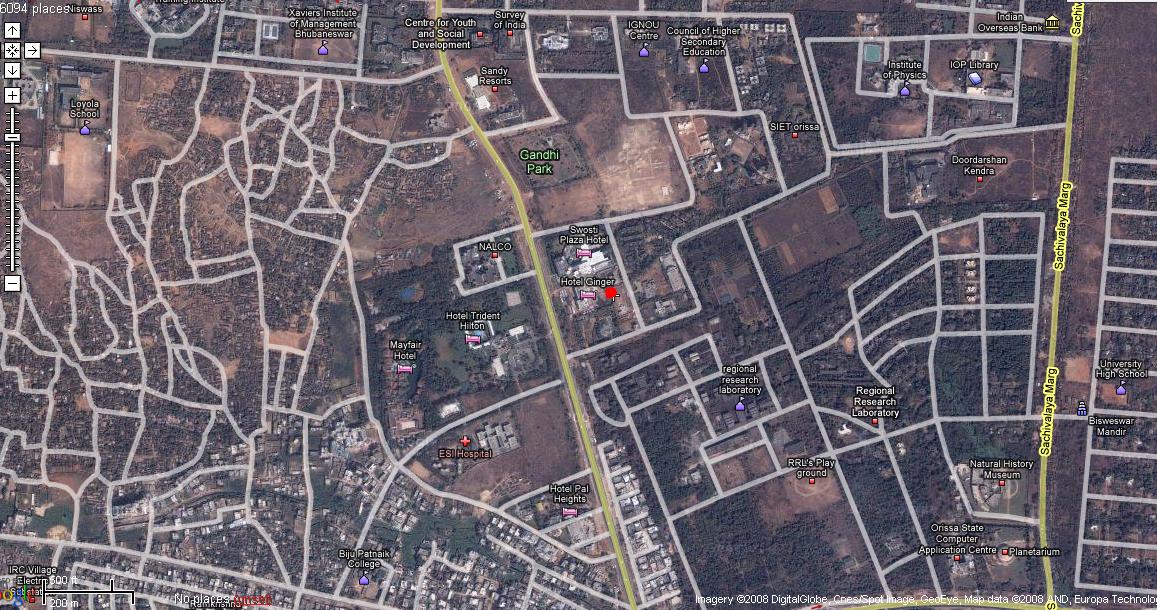
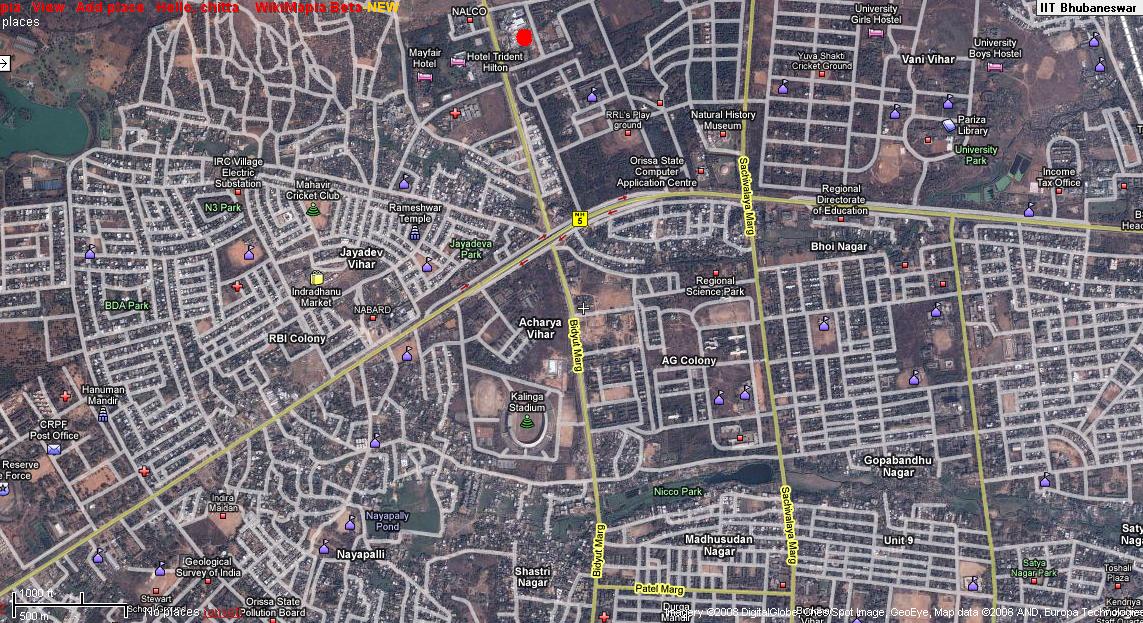
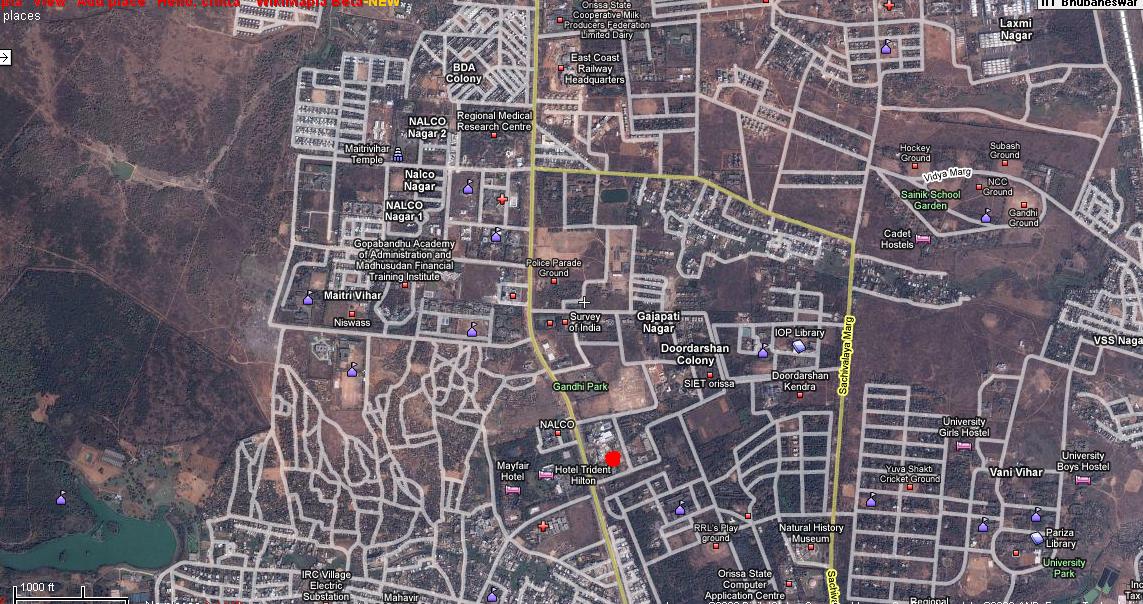
.jpg)
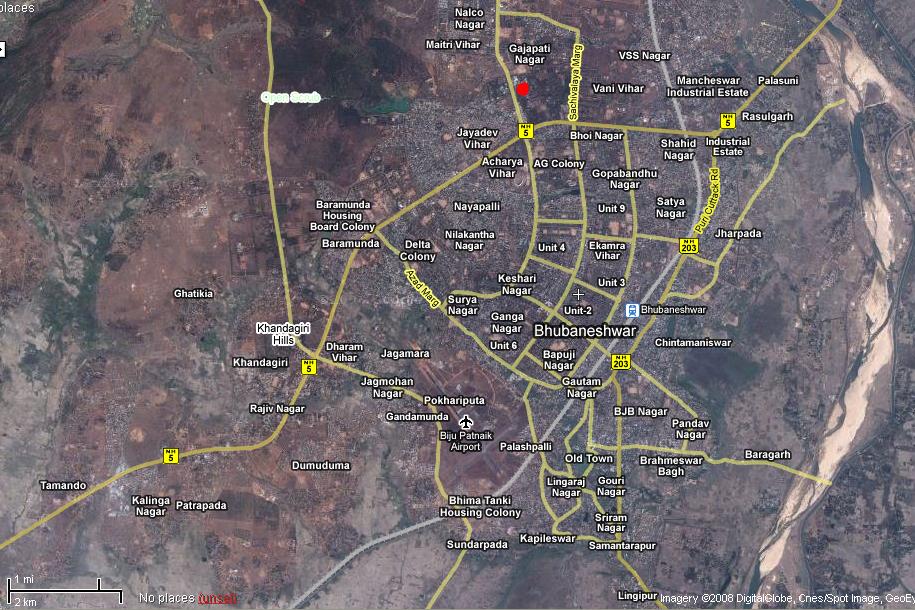
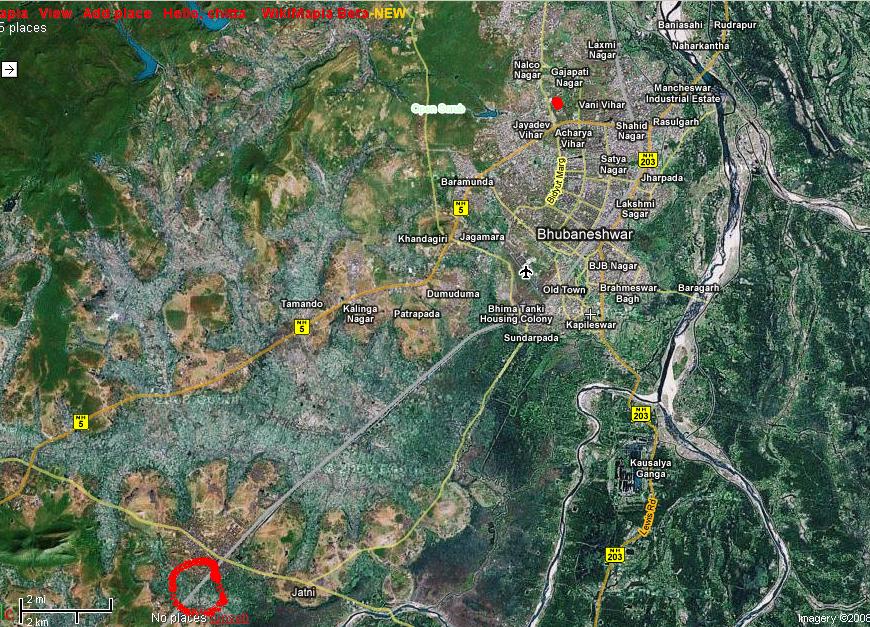
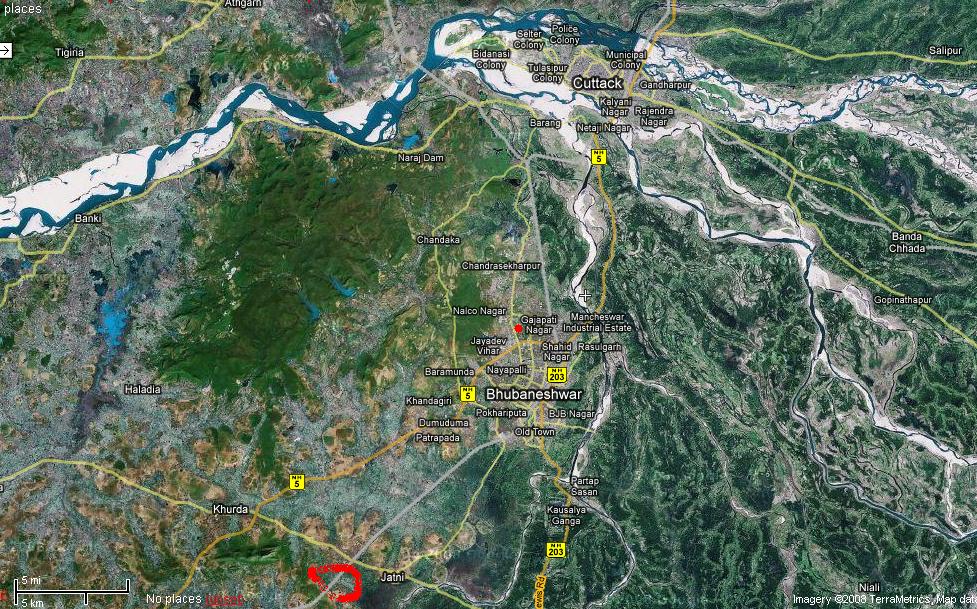
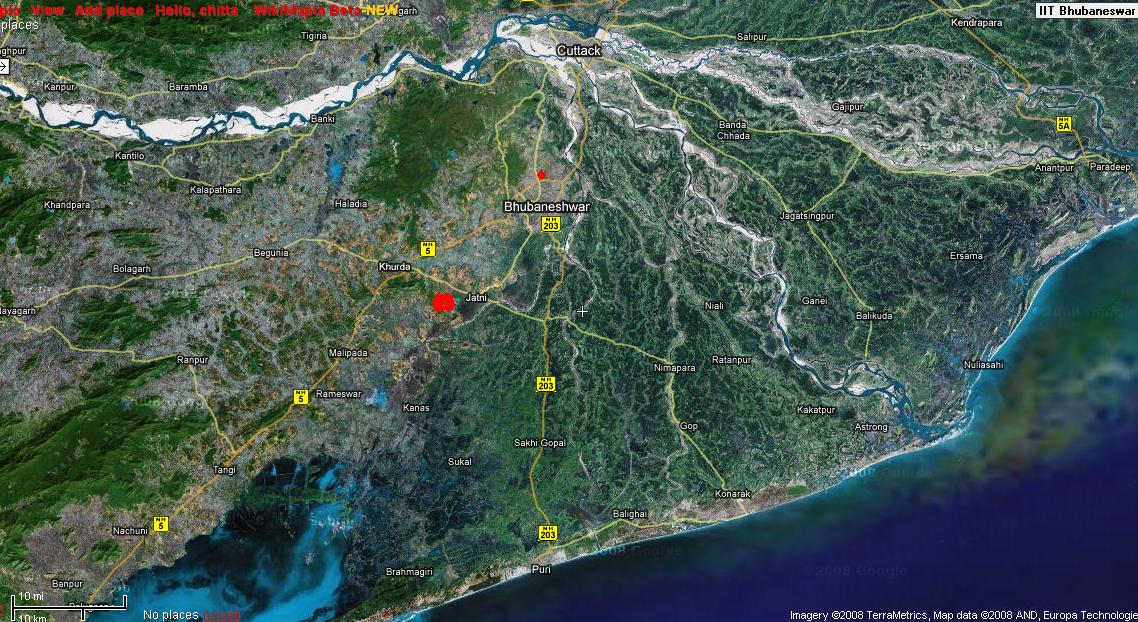
December 24th, 2008
Thanks to Debu for this.
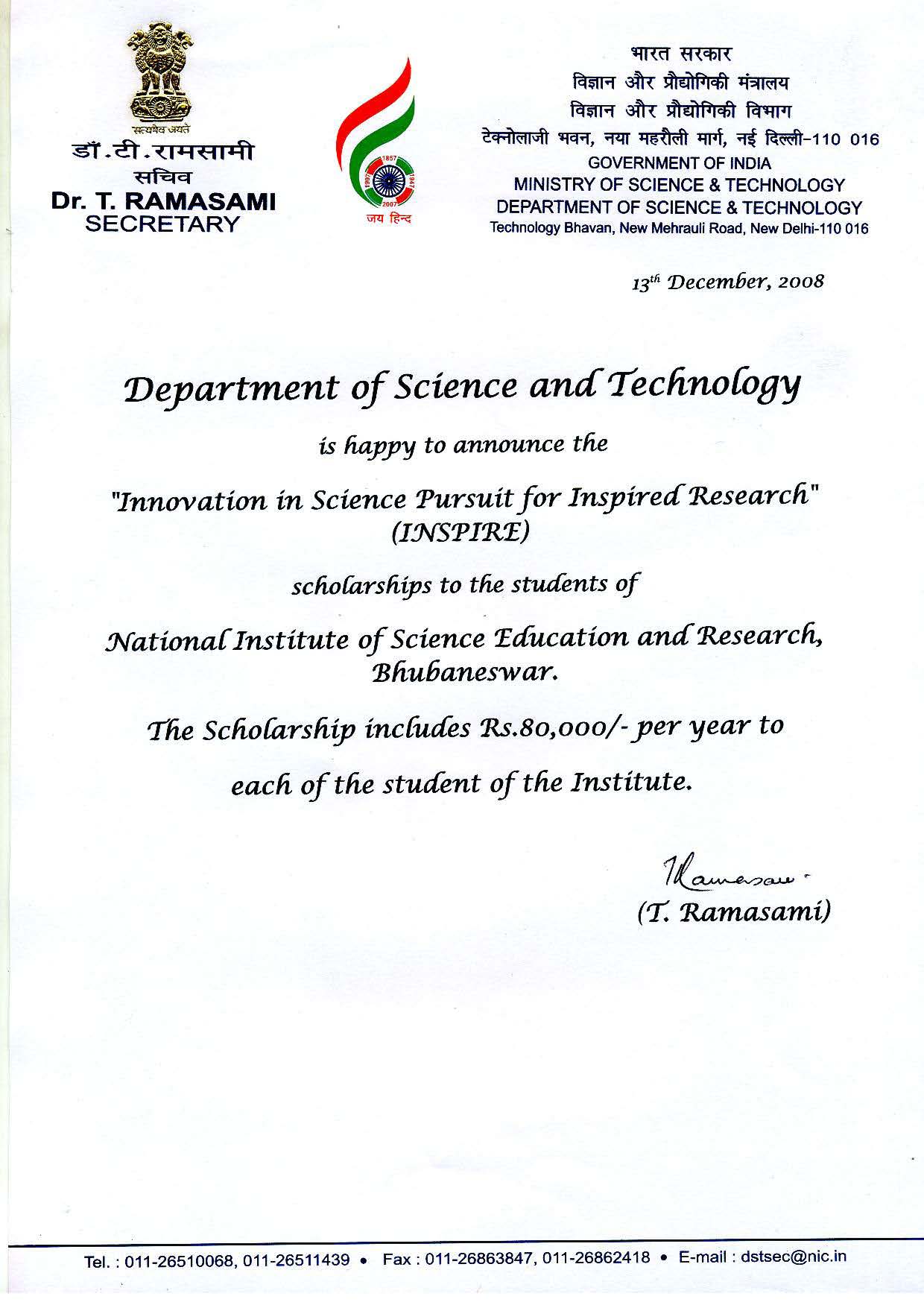
December 17th, 2008
Following is from Kalinga Times’ report on it.
The classes of IIT Bhubaneswar, which are now being held at IIT Kharagpur, will be conducted at the latter’s extension centre here from July next year.
The student strength of IIT Bhubaneswar will increase from the present 120 to 240 by July next.
All the 240 students of IIT Bhubaneswar will attend their classes in the extension centre of IIT Kharagpur which will be used as a temporary campus till IIT Bhubaneswar developed its own campus in the city.
… IIT Kharagpur is facilitating establishment of IIT Bhubaneswar as the mentor IIT appointed by the Central government.
The authorities of IIT Kharagpur are now constructing new buildings at their extension centre in the city to accommodate IIT Bhubaneswar till the later develops its own campus.
The process of appointment of teachers and other staff for IIT Bhubaneswar has also started. The process of selecting 30 faculty members was nearing completion, Dr. Damodar Acharya, Director of IIT Kharagpur and Chairman of the Governing Body of IIT Bhubaneswar, told reporters in Bhubaneswar on Sunday.
On the other hand, efforts were on to start construction of IIT Bhubaneswar’s own campus next year. A total of Rs 1,000 crore will be utilised for the establishment of the IIT.
Odisha government has already offered land at several locations around the city for the proposed campus for IIT Bhubaneswar. The site selection process will be over within a few weeks.
December 15th, 2008
Update2: The number 80,000 is inconsistent with the earlier announced number of Rs 100,000/year made in http://pib.nic.in/release/release.asp?relid=36632.
Update: See also http://www.pib.nic.in/release/release.asp?relid=45626 for the PM’s speech while launching the INSPIRE program.
Following is from a report in Telegraph.
India’s brightest students who choose to pursue science in college will get Rs 80,000 a year under a government scholarship to draw youngsters to careers in research.
The department of science and technology (DoT) today launched the nation’s largest-ever project to wean high-school students away from dreams of studying engineering or medicine towards BSc and MSc degrees.
Students who rank within 10,000 in the IIT Joint Entrance Examination and within 20,000 in the All India Engineering Entrance Examination but still choose BSc will be eligible for the scholarship, announced earlier this year but formally launched by Prime Minister Manmohan Singh today. Students who clear the central medical entrance exam but opt for BSc will also be eligible.
All students who come within the top 1 per cent both in the 10th and 12th standard exams of central or state boards may also apply for the Scholarship for Higher Education. The department of science expects to offer 10,000 scholarships every year.
Students of Indian Institutes of Science Education and Research (IISERs) and the National Institute of Science Education and Research (NISER), national science talent scholars and Olympiad medallists will also be eligible.
The scholarship will be available from BSc second year till the students complete their master’s. Students of IISER Pune, Calcutta, Mohali, Bhopal and Thiruvananthapuram will receive it this year. So will those of NISER Bhubaneswar.
… The project will also award Rs 5,000 every year to 200,000 students from classes VI to X — picked with help from the schools’ science faculties — for work on a school-level science project. It will provide doctoral fellowships and an assured five-year research career to postgraduate students.
The government will spend Rs 2,100 crore on the scheme in the next three years.
India’s science policy makers have long worried about the migration of meritorious students towards, traditionally, engineering and medicine and, in recent years, management and information technology. “This initiative is important for India from a long-term perspective,” said T. Ramasamy, DoT secretary. “We expect to begin seeing gains from this in about a decade or so from now.”
December 14th, 2008
(The following is compiled from various sources including wikipedia.)
|
IISER Kolkata
Director: Prof. Sushanta Dattagupta, Physics
- Ph.D. (Physics), Brookhaven National Laboratory, St. John’s University, New York, 1973
- M.Sc. (Physics), Calcutta University, 1967
- B.Sc.(Physics Honours), Calcutta University, 1965
- Lecturer in Physics, Presidency College, Kolkata (1968-69)
- Post-Doctoral Fellow, Carnegie-Mellon University, Pittsburgh (1973-75) & Senior Research Associate, University of Alberta (1975-76)
- Scientific Officer, Materials Science Laboratory, Indira Gandhi Centre for Atomic Research, Kalpakkam (1976-81)
- Reader, School of Physics, University of Hyderabad, Hyderabad (1981-86)
- Professor, School of Physical Sciences, JNU, New Delhi (1986-99)
- Dean, School of Physical Sciences, JNU, New Delhi (1987-89 & 1993-95)
- Director, S.N. Bose National Centre for Basic Sciences, Salt Lake, Kolkata (8 Feb. 1999 to 8 Apr, 2005)
- Director, Indian Institute of Science Education and Research (IISER), Kolkata (2006 -)
- Honorary Professor, Jawaharlal Nehru Centre for Advanced Scientific Research (2003 – )
- Honorary Professor, Indian Association for the Cultivation of Science (2005 – )
|
- Elected Fellow, Indian Academy of Sciences, Bangalore (1992)
- Elected Fellow, Indian National Science Academy, New Delhi (1994)
- Elected Fellow, The National Academy of Sciences, Allahabad (1995)
- Elected Fellow, The Academy of Sciences for the Developing World, (TWAS) (1999)
- Elected Fellow, West Bengal Academy of Science & Technology (2000)
- Young Scientist Medal, Indian National Science Academy (1977)
- Alexander von Humboldt Fellowship, tenured at the Institute for Solid State Physics, Juelich, Germany
(1984, May-July 1985, December 1987, January-June 1997, 2002 and 2003)
- Research Fellow, Indian National Science Academy (1987-89)
- Associate, International Centre for Theoretical Physics, Trieste, Italy (1985-91)
- Senior Associate, International Centre for Theoretical Physics, Trieste, Italy (1992-1997)
- Visiting Associate, Darwin College, Cambridge University (May-July 1993)
- Bibharani Devi Prize of Calcutta University (2002)
- DAE Raja Ramanna Award of the Jawaharlal Nehru Centre for Advanced Scientific Research (2002)
- Sisir Kumar Mitra Medal and Lecture of the Indian Science News Association (2004)
- Distinguished Lecturership Award for 2005-2006, Materials Research Society of India
- Swamy Atulananda Endowment Award Lecture, Ramakrishna Mission (2005)
- L.A. Meera Memorial Lecture (2005)
- Meghnad Saha Memorial Award of the National Academy of Sciences, Allahabad (2005)
- C.V. Raman Birth Centenary Award, 93rd Indian National Science Congress (2006) [ Photograph ]
- Visiting Fellow under the Distinguished Scientist Visitors’ Programme of the Faculty of Natural Sciences of Ben-Gurion University of the Negev, Beer-Sheva, Israel (2007-2008)
- J. C. Bose Fellowship of the Department of Science & Technology, India (2006-2010)
|
|
IISER Pune
Director: Prof. K. N. Ganesh, Chemistry
1967-1972 B.Sc and M.Sc (Bangalore University)
1972-1977, Ph.D (Delhi University)
1977-1980, Ph.D (Cambridge University, UK)
1981-1987, Scientist, Centre for Cellular and Molecular Biology, Hyderabad 1987-2006, Scientist, National Chemical Laboratory, Pune
1994-2006, Head, Division of Organic Chemistry (Synthesis), NCL, Pune ()
Since July 2006, Professor and Director, IISER Pune
|
1985: Science Academy Medal for Young Scientists, Indian National Science Academy, New Delhi.
1993: Fellow, Indian Academy of Sciences, Bangalore
1998: CSIR Bhatnagar Award in Chemical Sciences
1999: Fellow, Indian National Science Academy, Delhi
2004: Silver Medal, Chemical Research Society of India, Bangalore
2005: TWAS Prize in Chemical Sciences
2005: Elected Secretary, Biomolecular Chemistry Division, Sub Committee, IUPAC
2006: JC Bose Fellowship, Department of Science and Technology, India
2006: Fellow, Academy of Sciences for Developing World (TWAS), Trieste
|
|
IISER Mohali
Director: Prof. N. Sathyamurthy, Chemistry
He completed his B.Sc. and M.Sc. degrees from Annamalai University. Sathyamurthy moved to the United states to where he obtained his Ph.D degree at Oklahoma University in 1975. He further carried out postdoctoral research in nobel laurate J.C.Polanyi’s lab. After that Sathyamurthy joined Indian Institute of Technology Kanpur as a lecturer in 1978. Sathyamurthy became professor in 1985.
|
Fellow, Third World Academy of Sciences, Trieste, Italy 2005 |
|
IISER Bhopal
Director: Prof. Vinod K. Singh, Chemistry
B.Sc. 1978 D.A.V College, Azamgarh
M.Sc. 1980 Banaras Hindu University, Varanasi
Ph.D. 1986 M. S. University Baroda (Supervisor:Dr. Sukh Dev)
(Malti-Chem Research Centre, Nandesari)
Post doctoral:
* University of British Columbia, Canada 1986 – 1987(Advisor: Professor J. P. Kutney)
* Harvard University, U.S.A 1987-1990 (Advisor: Professor E. J. Corey, Nobel Laureate)
Director SPA Bhopal
06.10.08 – present
Umnag Gupta Chair Professor
IIT Kanpur
June 1, 2007 – present
Professor
IIT Kanpur
September 2001 – to-date
Associate Professor
IIT Kanpur
May 1997 – September 2001
Assistant Professor
IIT Kanpur
December 1990 – May 1997
Senior Scientist
Neurogen, USA
March – December, 1990
|
* Umang Gupta Chair Professorship (June 1, 2007 – to-date)
* Vigyan Ratna Award of U.P. (2006-2007)
* Ramanna Fellowship (2006)
* Bhagyatara Award (2006)
* Fellow, Indian Academy of Sciences (2005)
* Shanti Swarup Bhatnagar Award (2004)
* Prof. R.D. Desai 80th Birthday Commemoration Award (2004)
* Fellow, National Academy of Sciences, India (2004)
* CRSI Bronze Medal (2003)
* Rajib Goyal Prize (2002)
* Prof. N. S. Narsimhan Endowment Award (2002)
* Swarnajayanti Fellowship Award (1998) |
|
IISER Tiruvanthapuram
Director: Prof. E. D Jemmis, Chemistry
Eluvathingal D. Jemmis was born in Chevoor, Kerala and educated at the village school. After obtaining B.Sc. (University of Calicut; University College, Trivandrum and St. Thomas College, Thrissur) and M.Sc. ( Indian Institute of Technology, Kanpur) Jemmis moved to Princeton University in 1973 to work with Prof. Paul von Rague Schleyer. During the formal Princeton years moving along with his supervisor, Jemmis spent a semester at the University of Munich (Fall, 1974) and four semesters at the University of Erlangen-Nuernberg (1976-77). After several collaborative projects with his supervisor and Professors Lee Allen and John Pople, a Ph.D. degree was received from Princeton in 1978. A two year postdoc at Cornell University (Prof. Roald Hoffmann) followed. In 1980 Jemmis joined the then fledgling School of Chemistry,University of Hyderabad where he became a Professor in 1990. After 25 years in Hyderabad, Dr. Jemmis accepted an invitation from the Indian Institute of Science, Bangalore and joined the Department of Inorganic and Physical Chemistry of IISc.
|
Jemmis was elected Fellow of the Indian Academy of Sciences, Bangalore (1992), the Indian National Science Academy, New Delhi (1998), the National Academy of Sciences, India, Allahabad (2003) and the Academy of Sciences for the Developing World, Trieste, Italy (2004) and received many awards and honours (see biodata for details) including the Shanti Swarup Bhatnagar Prize, Council of Scientific and Industrial Research, CSIR, New Delhi (1994). Dr. Jemmis was awarded the J. C. Bose National Fellowship of the Department of Science and Technology, New Delhi, in 2006. |
|
NISER Bhubaneswar
Director: Prof. T. K. Chandrashekar, Chemistry
B.Sc. : 1976, Mysore University, Karnataka
M.Sc. : 1978 Mysore University, Karnataka
Ph.D. : 1982 Indian Institute of Science, Bangalore (Supervisor: Prof. V. Krishnan)
Post-Doctoral : University of Massachusetts, Boston, USA 1982-1984
Res. Associate : Michigan State University, East Lansing, USA 1984-1986
1986 July – 1987 March Lecturer, Department of Chemistry, I.I.T.Kanpur
* 1987 April – 1991 February Assistant Professor, Department of Chemistry, I.I.T. Kanpur
* 1991 March – 1995 November Associate Professor, Department of Chemistry, I.I.T.Kanpur
* 1995 November – 2003 Nov Professor, Department of Chemistry, I.I.T. Kanpur
* 2003 December onwards Director, RRL, Trivandrum
|
1 McKnight Fellowship, Michigan, USA, 1984 – 1986
2 Homi Bhabha Award for Excellence in Research – 1993
3 Alexander Von Humboldt Fellowship: 1993 – 1994
4 Fellow of National Academy of Sciences, Allahabad – 1996
5 Fellow of Indian Academy of Sciences, Bangalore – 1999
6 CRSI Bronze Medal for Significant Contributions in Chemistry – 2000
7 Shanti Swarup Bhatnagar Prize in Chemical Sciences for the year – 2001
8 Fellow of Indian National Science Academy, New Delhi – 2002
9 Professor P. Ray Memorial Award, Indian Chemical Society, Kolkata – 2002
10 Chemito Award – 2003
11 J.C.Bose Fellowship for the year – 2006
|
December 11th, 2008
Going through the NISER call for tenders for providing consultancy for the academic and residential townships, available at http://www.dcsem.gov.in/Page/Tender.htm, I have the following suggestions to the advisory specs mentioned in that document.
1. The whole campus should be universally accessible. (For too long public spaces are designed in India without taking into account people with disabilities.)
2. Research labs in NISER should have the space to accommodate all students in the 4th and 5th year of their integrated M.Sc program. In other words, when students are in their 4th and 5th year they should be required to be part of a research lab, and thus the research labs should have space to accommodate them.
3. Instead of just a cafeteria, most US universities have a "Student Union" which has multiple eating places, bank (with ATM), post office, book store, entertainment options (such as chess, pool, etc.), etc. Some even have a movie theater. The student union should be a one stop place where students (and faculty) can not only eat but also transact other necessary businesses.
4. There should be plan for designing the landscape of the campus as a combination of a botanical garden (with trees labeled with their botanical name and their place of origin) and science based sculptures. Local industries may be approached for sponsoring part of this.
5. Finally the whole design should be such that there is room to expand. Otherwise 20-30 yrs down the road, NISER will suffer the same problem that IISc is facing now in terms of lack of room to grow.
December 3rd, 2008
(Following is from http://www.dcsem.gov.in/page/pcdtbrp3.pdf)
RESIDENTIAL TOWNSHIP
|
SN
|
Description
|
Area per Unit
|
Units consid ered
|
TotalArea Sq.m.
|
|
|
(A) HOSTEL Complex
|
|
|
1
|
Double occupancy rooms with common toilet (600 students)
|
40
|
300
|
12000.00
|
|
2
|
Single occupancy common toilet
|
22
|
400
|
8800.00
|
|
3
|
Single occupancy common toilet -Phd
|
22
|
300
|
6600.00
|
|
4
|
Single occupancy attached toilet Phd
|
25
|
600
|
15000
|
|
5
|
Post doc staff
|
36
|
150
|
5400
|
|
|
|
47800.00 sq.m.
|
|
|
(B) Residential Accomodation for Faculty/Staff
|
|
|
(i)
|
Director E3
|
350
|
1
|
350.00
|
|
()
|
E1 (deans)
|
255.73
|
4
|
1022.32
|
|
()
|
E (prof/senior-prof/registrar)
|
189.61
|
72
|
13652.00
|
|
(iv)
|
D (asstt.prof./seniornon-teaching sta)
|
94.27
|
144
|
13574.00
|
|
(v)
|
C
|
67.17
|
75
|
5038.00
|
|
(vi)
|
B
|
55.04
|
75
|
4128.00
|
|
(v)
|
A
|
44.37
|
75
|
3328.00
|
|
(v)
|
Flatlets (transit camp)
|
36.00
|
45
|
1620.00
|
|
|
|
|
|
42712.32 sq.m.
|
|
|
(C) OTHER AM ENITIES
|
|
|
|
|
1
|
Day care centre
|
|
|
1500.00
|
|
2
|
Primary School
|
|
|
860.00
|
|
3
|
Higher secondary
|
|
|
2200.00
|
|
4
|
Hospital 20 bed
|
|
|
2500.00
|
|
5
|
Shopping
|
|
|
840.00
|
|
6
|
Community Centre
|
|
|
500.00
|
|
7
|
Guest House
|
|
|
3000.00
|
|
|
Total Residential As per Report 102000.00 sq.m.
|
101912.32 sq.m
|
December 3rd, 2008
(From http://www.dcsem.gov.in/page/pcdtb1.pdf.)
ACADEMIC TOWNSHIP & SPORTS COM PLEX
|
SN
|
Description
|
Area per Unit
|
Units consid ered
|
Total Area Sq.m .
|
|
|
(A) Academ ic Township
|
|
|
|
|
1
|
Class rooms
|
|
|
5000.00
|
|
2
|
Central Library
|
|
|
5000.00
|
|
3
|
Academic Schools
|
|
|
20000.00
|
|
4
|
Computer Centre
|
|
|
500.00
|
|
5
|
Admn. Office
|
|
|
2500.00
|
|
6
|
Cafetaria
|
|
|
1000.00
|
|
7
|
Auditorium Complex
|
|
|
7500.00
|
|
8
|
Teaching labs
|
|
|
7000.00
|
|
9
|
Research Lab
|
|
|
8000.00
|
|
|
|
|
|
56500.00
|
|
|
(B) Sportscom plex
|
|
|
|
|
1
|
Aquatic Facility
|
|
|
2000.00
|
|
2
|
Playground
|
|
|
18000.00 (Playground)
|
Hostel requirements:
1 for Integrated 5-yr M.Sc course (1000 students in full fledged operation): double room w/o attached toilet for first three years. Single room w/o attached toilet for the last two years;
2 for integrated M.Sc + PhD course (300 students total): Single room w/o attached toilet for the first two years (like other M.Sc. students), single occupancy with attached toilet for PhD part;
3 PhD students : total 300 (other than from (2)) : same as other PhD students;
4 Post-doc fellows (150 max.) : flatlets.
Classroom complex (service area is included in the bulk): .
|
Item
|
Unitarea
|
No of units
|
Total area
|
|
Lecture hall for 250 seats
|
450 sq.m
|
2
|
900
|
|
Do- for 100-120 seats
|
200 sq.m .
|
5
|
1000
|
|
Tutorial rooms (30 seats)
|
50 sq.m .
|
20
|
1000
|
|
Small lecture rooms (60 seats)
|
100
|
18
|
1800
|
|
Common rooms (boys)
|
200
|
1
|
200
|
|
Common room girls
|
100
|
1
|
100
|
|
Total
|
|
|
5000
|
Teachinglabs (7000sq.m.) Break-up of (8000sq.m.)
Physics 2000 Research Labs
Chem istry 2000 Biology 3000
Biology 2000 Chem istry 3000
Math+Com p.sc. 500 Physics 2000
Earth Sc 500 Total 8000
Total 7000
Academic Schools(20000 sq.m.)
(A) School adm inistration (for six schools)
School chairman’s offices (100 sq.m .*6) 600 sq ms
Meeting rooms (small, two each, 50sq.m X2*6)) 600
Seminar halls (one each, 150 sq.m . *5) 750
Committee rooms (one each, 120 sq.m . *5) 600
School libraries and outreach halls (200 sq.m .*6) 1200
Total 3750
(B) Faculty and Research Scholaroffices
Each faculty office will be standard size (5.5m X 3.6m ≈20 sq.m .). There will be 200 such offices, senior faculty (150) being given independent offices, and junior faculty (100) sharing two each. Post-Doctoral Fellows (PDFs), associates and visiting faculty will share (double) a normal faculty office. Since visiting faculty will be both short and long-term type, it is assumed that 50 rooms, seating 100 people, may be adequate. Office space for PhD scholars will be provided by sharing three scholars in one room. A good proportion of scholars are usually accommodated in research labs. However sitting space is provided for about 500.
Faculty offices (200 X 20) 4000
Visitingfaculty(50 X 20) 1000
PDF(150atanygiventime),150X10 1500
PhD scholars 3250
Total 9750
(C) Research Labs
Biology 2500
Chem istry 2500
Physics 1000
Total 6500
Total 20000
Note: The area mentioned above are indicative. However the Consultant may change the same as per planning requirement
December 3rd, 2008
Following are excerpts from a report in Business Standard.
The Orissa government has geared up to meet the requirement of external infrastructure facilities for the proposed Indian Institute of Technology (IIT) near Bhubaneswar.
Apart from providing road communication facilities, the government will also supply water and electricity to the site at Arugul mouza in Jatni Tehsil.
The Centre had asked the Orissa government to provide free land and develop external infrastructure for the proposed institute.
The state industry department has drawn a three-year development plan for the IIT. According to preliminary estimates, the investment will be about Rs 50 crore.
While providing water supply from Naraj to the IIT site is estimated to cost Rs 24 crore, another Rs 20 crore will be spent on supplying electricity at the project location. Besides, a flyover will have to be constructed and roads inside the campus need to be redesigned to bypass the railway line running through the site.
The state government has selected 891 acres in Arugul mouza for setting up the IIT. There is a patch of 20 acres of private land in the identified 891 acres and the state government will acquire it.
… The industry department is in talks with other departments like IT, urban development and science and technology for integrating the water supply system of the IIT with that of Infocity-II, Khurda-Jatni townships and National Institute of Science Education and Research (NISER), coming up in the same area.
If this comes through, the cost of supplying water to the IIT campus will be relatively low, sources added.
Similarly, the electricity requirement of the IIT campus is estimated at 20 Mw. While the cost of 132 KV transmission line will be constructed by OPTCL, the required 33 KV/11KV line will be laid by power utility Central Electricity Supply Utility (CESU).
Meanwhile, the visit of the Site Selection Committee (SSC) for the IIT in Orissa has been delayed. …
November 28th, 2008
The Indian government has announced to have 16 central universities in states that do not have any. Following are the states and the locations in those states that are being championed by those states. In some states existing universities will be upgraded to central university status:
- Bihar – Near Motihari, East Champaran District
- Chhatisgarh – Guru Ghasidas University, Bilaspur will be upgraded (approved by cabinet)
-
- Gujarat – Gandhinagar
- Haryana – Mirzapur Bachhor Village In Mahendergarh District
- Himachal Pradesh – Kangra
- Jharkhand – Khunti (near Ranchi)
- J & K – Dual Campus in Jammu & Srinagar
- Karnataka – Suntanur-Kadaganchi on the Aland Road , Gulbarga
- Kerala – Kasaragod
- Madhya Pradesh – Dr. Hari Singh Gaur University, Sagar will be upgraded (approved by cabinet)
- Orissa – Koraput
- Punjab – Bathinda
- Rajasthan – Bikaner
- Tamil Nadu – Tiruvarur
- Uttarakhand – Hemwati Nandan Bahuguna Garhwal University will be upgraded (approved by cabinet)
The location of the new IITs are (the existing ones are at Bombay, Delhi, Kharagpur, Kanpur, Madras, Guwahati and Roorkee and IT BHU is to be upgraded):
- Andhra Pradesh – Hyderabad
- Bihar – Patna
- Gujarat – Gandhinagar
- Himachal Pradesh – Mandi
- Madhya Pradesh – Indore
- Orissa – Bhubaneswar
- Punjab – Rupnagar
- Rajasthan – Jodhpur
The location of the new IIMs are (the existing ones are at Ahmedabad, Bangalore, Kolkata, Indore, Kozhikode and Lucknow) :
- Uttarakhand – Dehradun
- J & K – Srinagar
- Chhatisgarh – Raipur
- Haryana – Rohtak
- Jharkhand – Kanke, Ranchi
- Tamil Nadu – Tiruchi
- Meghalaya – Shillong
November 22nd, 2008
Following is an excerpt from a report in Times of India. (Thanks to Prof. Ratan Ghosh for the pointer.)
In the coming years, the IIT palette will have on offer a range of shades beyond the cut-and-dry coding courses. A bunch of doctors, historians, perhaps policy makers too, could boast of IIT degrees.
… the XIth five-year committee for higher education is working with these centres of excellence to expand their charts. The committee, headed by educationist Yash Pal, that is meeting IIT heads on Friday will discuss how the tech schools can change their character and, like American universities, enlarge their menu.
"Currently, the IITs are premier undergraduate engineering schools doing some postgraduation and research work. Now, we want to give them a bigger role," Yash Pal told TOI. The noted scientist said that he had discussed his suggestions with some IIT directors and that a clearer picture would emerge after this week’s meeting.
While the IITs will be given more oxygen in terms of starting courses of their choice, it’s difficult to predict whether the new subjects offered will compare in excellence with the engineering departments, or be relegated to the sidelines, like the IITs’ management schools. However, Yash Pal said, "All great universities around the world offer a range of undergraduate courses. Our IITs can’t be great unless they think in that direction."
The committee is looking at the Big Daddy of engineering colleges for inspiration. "If MIT (Massachusetts Institute of Technology) or Caltech (California Institute of Technology) can offer a wider range of programmes that are well-known, why not the IITs? Our IITs have produced wonderful engineers for the country. It’s time they looked at offering more," he added.
Former Indian Institute of Science director Govardhan Mehta, who’s also on the committee, said that the country was currently at a stage where an institute running one programme was also being termed a university. "However, a university, as defined in the ninth century, is an institution with a confluence of many disciplines where research and teaching are carried out. While expansion of courses in the IITs is what our committee is thinking of, Friday’s meeting will give us a chance to know what’s in the IIT heads’ minds," he said.
… IIT-Guwahati director Gautam Barua said, "There has been some suggestion that the IITs start programmes in areas other than science and technology. I do not have a problem with doing that if our focus is clearly defined."
… Educationist and former director of IIT-Chennai P V Indiresan, who has spent a large part of his life in the IIT system, said the institutes had been synonymous with excellence and they must not start any programmes unless they got very good faculty for the same.
How the IITs will rise to the challenge remains to be seen. What’s certain, however, is that the flow charts on their lush campuses are set to be redrawn.
November 20th, 2008

The eligibility criteria has been made to discourage multi-year preparation for IIT JEE. To be eligible for IIT JEE 2009 students must NOT have passed their qualifying exam before Oct 1, 2007 and must not have taken admission to an IIT/IT-BHU/ISMU in the past by paying full fees. They must also have secured at least 60% in their qualifying exam. See details at the IIT JEE 2009 sites such as at IIT Guwahati.
November 10th, 2008
The Bhubaneswar-Cuttack-Puri area will have 25 universities. Following is a slide on it from my presentation at the Invest India Symposium.
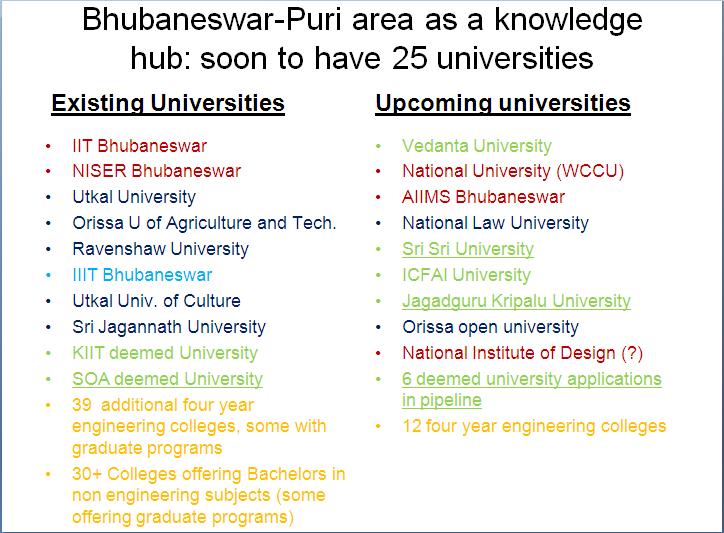
The color coding in the above slides is as follows:
- Red – Central govt funded universities/institutes
- Navy Blue: State govt. funded universities
- Light blue: PPP
- Green: Privately created universities and deemed universities
- Orange: Mention about colleges that are part of various universities
To compare this with the universities in the major metropolitan areas of the US and the state of California, please see:
- Boston: 18 four year colleges and universities in the city and 24 in the surrounding areas, some listed twice as they have campuses in the city as well as in the surrounding areas.
- New York:83 colleges and universities in New York City, not counting the 22 individual colleges of CUNY.
- Los Angeles:
- Chicago: 43 colleges and universities
- California
The reason we use California as a reference point is that the population of California (34,600,463 in 2001) is close to the population of Orissa (2001: 36,804,660).
November 8th, 2008
Next Posts
Previous Posts



.jpg)






